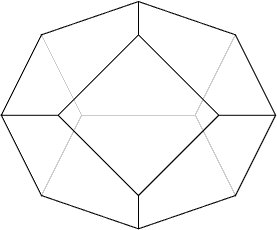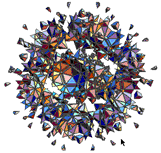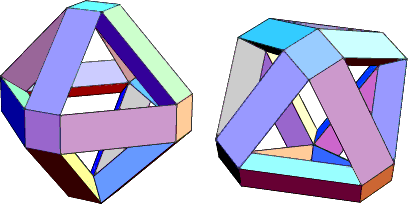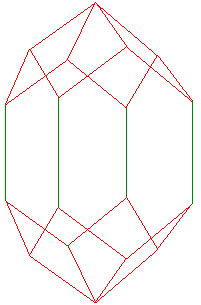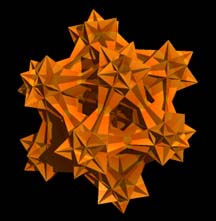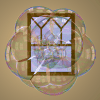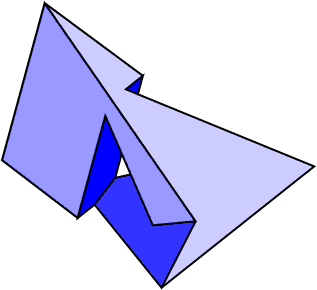|
Polyhedra and Polytopes
This page includes pointers on geometric properties of polygons,
polyhedra, and higher dimensional polytopes (particularly convex
polytopes).
Bob
Allanson's Polyhedra Page. Nice animated-GIF line art of the
Platonic solids, Archimedean solids, and Archimedean duals.
Maurice
Starck's Polyhedra Page. Several unusual all space fillers.
Almost
research-related maths pictures. A. Kepert approximates
superellipsoids by polyhedra.
Archimedean
polyhedra, Miroslav Vicher.
Eric Weisstein lists
properties
and pictures of the Archimedean solids.
Rolf Asmund's polyhedra page.
Associahedron
and Permutahedron.
The associahedron represents the set of triangulations of a hexagon,
with edges representing flips; the permutahedron represents the set of
permutations of four objects, with edges representing swaps.
This strangely asymmetric view of the associahedron (as an animated gif)
shows that it has some kind of geometric relation with the permutahedron:
it can be formed by cutting the permutahedron on two planes.
A more symmetric view is below.
See also a
more detailed description of the associahedron,
, and
Jean-Louis Loday's paper
on associahedron coordinates.
David Bailey's
world of tesselations.
Primarily consists of Escher-like drawings but also includes
an interesting section about Kepler's work on polyhedra.
The bellows
conjecture, R. Connelly, I. Sabitov and A. Walz in Contributions to
Algebra and Geometry , volume 38 (1997), No.1, 1-10. Connelly had
previously discovered
non-convex polyhedra which are flexible (can move through a continuous
family of shapes without bending or otherwise deforming any faces);
these authors prove that in any such example, the volume remains
constant throughout the flexing motion.
The charged particle
model: polytopes and optimal packing of p points in n dimensional spheres.
Circumnavigating
a cube and a tetrahedron, Henry Bottomley.
Cognitive Engineering
Lab, Java applets for exploring tilings, symmetry, polyhedra, and
four-dimensional polytopes.
Complex
polytope. A diagram representing a complex polytope, from
H. S. M. Coxeter's home
page.
A
computational approach to tilings. Daniel Huson investigates the
combinatorics of periodic tilings in two and three dimensions, including
a classification of the tilings by shapes topologically equivalent to
the five Platonic solids.
Convex
Archimedean polychoremata, 4-dimensional analogues of the
semiregular solids, described by Coxeter-Dynkin diagrams
representing their symmetry groups.
A Counterexample to Borsuk's Conjecture, J. Kahn and G. Kalai,
Bull. AMS 29 (1993). Partitioning certain high-dimensional polytopes
into pieces with smaller diameter requires a number of pieces
exponential in the dimension.
Deltahedra, polyhedra with equilateral triangle faces. From Eric Weisstein's treasure trove of mathematics.
Dodecafoam.
A fractal froth of polyhedra fills space.
Dodecahedron
measures, Paul Kunkel.
Domegalomaniahedron.
Clive Tooth makes polyhedra out of his
deep and inscrutable singular name.
All the fair dice.
Pictures of the polyhedra which can be used as dice,
in that there is a symmetry taking any face to any other face.
Chris Fearnley's 5 and 25 Frequency Geodesic Spheres rendered by POV-Ray.
Five
Platonic solids and a soccerball by Paul Flavin.
Flexible polyhedra (Becky Alexander and Joseph O'Rourke) From Dave Rusin's known math pages.
Geodesic
math. Apparently this means links to pages about polyhedra by Geodesic Designs Inc.
Geometria
Java-based software for constructing and measuring polyhedra
by transforming and slicing predefined starting blocks by Geometria.
Geometry and the Imagination in Minneapolis.
Notes from a workshop led by Conway, Doyle, Gilman, and Thurston.
Includes several sections on polyhedra, knots, and symmetry groups.
Glowing green rhombic triacontahedra in space.
Rendered by Rob Wieringa for the May-June 1997 Internet Ray Tracing Competition.
The golden
section and Euclid's construction of the dodecahedron, and
more
on the dodecahedron and icosahedron,
H. Serras, Ghent.
Polyhedra -
homage to U. A. Graziotti.
Great
triambic icosidodecahedron quilt,
made by Mark Newbold and Sarah Mylchreest with the aid of
Mark's hyperspace star polytope slicer.
Hilbert's
3rd Problem and Dehn Invariants.
How to tell whether two polyhedra can be dissected into each other.
See also Walter
Neumann's paper connecting these ideas with problems of
classifying manifolds.
Hyperspace star
polytope slicer, Java animation by Mark Newbold.
Icosamonohedra,
icosahedra made from congruent but not necessarily equilateral triangles.
by Becky Alexander and Joseph O'Rourke
Guy Inchbald's
polyhedra pages.
Stellations, hendecahedra, duality, space-fillers, quasicrystals, and more.
The International
Bone-Roller's Guild ponders the
isohedra:
polyhedra that can act as fair dice, because all faces are symmetric to
each other.
Investigating
Patterns: Symmetry and Tessellations.
Companion site to a middle school text by Jill Britton,
with links to many other web sites involving symmetry or tiling.
Johnson Solids, convex polyhedra with regular faces. From Eric Weisstein's
treasure trove of mathematics.
Sándor Kabai's
mathematical graphics, primarily polyhedra and 3d fractals.
Kepler-Poinsot
Solids, concave polyhedra with star-shaped faces. From Eric
Weisstein's treasure trove of mathematics. See also
H. Serras'
page on Kepler-Poinsot solids.
3-Manifolds from regular solids.
Brent Everitt lists the finite volume orientable hyperbolic and
spherical 3-manifolds obtained by identifying the faces of regular solids.
Martin's pretty
polyhedra. Simulation of particles repelling each other on the
sphere produces nice triangulations of its surface.
Mathematica Graphics Gallery: Polyhedra
Minesweeper
on Archimedean polyhedra, Robert Webb.
Netlib polyhedra.
by Jack Dongarra and Eric Grosse. Coordinates for regular and Archimedean polyhedra,
prisms, anti-prisms, and more.
Nine.
Drew Olbrich discovers the associahedron by evenly spacing nine points
on a sphere and dualizing.
Nonorthogonal polyhedra built from rectangles.
Melody Donoso and Joe O'Rourke answer an open question of Biedl, Lubiw,
and Sun.
Parallelopoids by Paul Bourke..
All space fillers
Pappus
on the Archimedean solids. Translation of an excerpt of a fourth century
geometry text.
Penumbral shadows of polygons
form projections of four-dimensional polytopes.
From the Graphics Center's graphics archives.
Pictures of 3d and 4d regular solids, R. Koch, U. Oregon.
Koch also provides some
4D regular solid visualization applets.
The
Platonic solids. With Java viewers for interactive manipulation. Peter Alfeld, Utah.
Platonic
solids and quaternion groups, J. Baez.
Platonic spheresby Dr. Karl- Dietrich Neubert.
Java animation, with a discussion of platonic solid classification,
Euler's formula, and sphere symmetries.
Poly by Pedagoguery Software Inc. Windows/Mac shareware
for exploring various classes of polyhedra including Platonic solids,
Archimedean solids, Johnson solids, etc. Includes perspective views,
Shlegel diagrams, and unfolded nets.
Polygonal and polyhedral geometry. Dave Rusin, Northern Illinois U.
Polygons,
polyhedra, polytopes, R. Towle.
Polyhedra
collection, V. Bulatov.
Polyhedra
exhibition.
Many regular-polyhedron compounds, rendered in povray by Alexandre Buchmann.
Polyhedra
pastimes, links to teaching activities collected by J. Britton.
Polyhedron,
polyhedra, polytopes, ... - Numericana.
Puzzles
with polyhedra and numbers,
J. Rezende.
Some questions about labeling edges of platonic solids with numbers,
and their connections with group theory.
Quark constructions.
The sun4v.qc Team investigates polyhedra that fit together
to form a modular set of building blocks.
A quasi-polynomial bound for the diameter of graphs of polyhedra,
G. Kalai and D. Kleitman, Bull. AMS 26 (1992). A famous open conjecture in polyhedral
combinatorics (with applications to e.g. the simplex method in linear
programming) states that any two vertices of an n-face polytope are
linked by a chain of O(n) edges. This paper gives the weaker bound
O(nlog d).
Realization Spaces of 4-polytopes are Universal,
G. Ziegler and J. Richter-Gebert, Bull. AMS 32 (1995).
Rhombic
spirallohedra, concave rhombus-faced polyhedra that tile space,
R. Towle.
Ruler and Compass by Literka.
Mathematical web site including special sections on the
geometry of
polyhedrons and
geometry
of polytopes.
SMAPO
library of polytopes encoding the solutions to optimization problems
such as the TSP.
Sperical polyhedra by Muarice Starck
The "campanus" sphere and some geodesic domes.
Soap bubble 120-cell
from the Geometry Center archives.
Stella by Rob Webb.
Windows software for visualizing regular and semi-regular polyhedra and
their stellations, morphing them into each other, drawing unfolded nets for
making paper models, and exporting polyhedra to various 3d design packages.
Stellations
of the dodecahedron stereoscopically animated in Java by Mark Newbold.
Sterescopic polyhedra
rendered with POVray by Mark Newbold.
Structors.
Panagiotis Karagiorgis thinks he can get people to pay large sums of
money for exclusive rights to use four-dimensional regular polytopes
as building floor plans. But he does have some pretty pictures...
Student of
Hyperspace. Pictures of 6 regular polytopes, E. Swab.
Superliminal
Geometry. by Melinda Green.Topics include deltahedra, infinite polyhedra, and flexible
polyhedra.
Symmetry,
tilings, and polyhedra, S. Dutch.
Synergetic
geometry, Richard Hawkins' digital archive. Animations and 3d
models of polyhedra and tensegrity structures. Very
bandwidth-intensive.
Tom
Ace has more images as well as a downloadable unfolded pattern
for making your own copy.
See also Dave Rusin's page on
polyhedral tori with few vertices.
3D-Geometrie.
T. E. Dorozinski provides a gallery of images of 3d polyhedra,
2d and 3d tilings, and subdivisions of curved surfaces.
Uniform
polychora.
A somewhat generalized definition of 4d polytopes,
investigated and classified by J. Bowers, the polyhedron dude.
See also the dude's pages on
4d polytwisters
and
3d
uniform polyhedron nomenclature.
Uniform polyhedra.
Computed by Roman Maeder using a Mathematica
implementation of a method of Zvi Har'El.
Maeder also includes separately a picture of the
20 convex uniform polyhedra, and descriptions of the
59
stellations of the icosahedra.
Uniform
polyhedra in POV-ray format, by Russell Towle.
Variations of Uniform Polyhedra, Vince Matsko.
Visual
techniques for computing polyhedral volumes.
T. V. Raman and M. S. Krishnamoorthy use Zome-based ideas
to derive simple expressions for the volumes of the Platonic solids
and related shapes.
Visualization of the Carrillo-Lipman Polytopeby Peter Serocka. Geometry arising from the simultaneous comparison of multiple DNA or protein sequences.
Volumes of pieces of a dodecahedron.
David Epstein (not me!) wonders why parallel slices through the layers
of vertices of a dodecahedron produce equal-volume chunks.
Waterman
polyhedra by Steve Waterman.
convex hulls as determined by employing incremental, root of an integer, radial sweeps upon the ccp.
Why "snub cube"?
John Conway provides a lesson on polyhedron nomenclature and etymology.
From the geometry.research archives.
|
